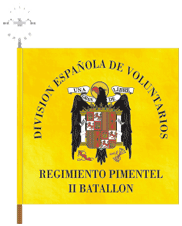
image by Sergio Camero and Luis Miguel Arias Perez, 05 May 2003

Last modified: 2015-07-29 by ivan sache
Keywords: blue division | división azul |
Links: FOTW homepage |
search |
disclaimer and copyright |
write us |
mirrors
See also:
Juan Morales asked, "The Blue Legion is widely regarded as one of the finest outfits that fought in the Soviet front. What flag did it have?". I guess he refers to the Blue Division, the name commonly given to the German Army's 250. Infanterie Regiment made up of Spanish volunteers which fought on the Eastern Front. I seem to recall that their Colours were those of any other Spanish regiment (a 1:1 Spanish flag with centered coat-of-arms) but with some reference to the German name in the inscriptions on the flag.
Santiago Dotor, 12 Nov 1999
Actually, Blue Legion is not exactly the same as Blue Division. As Santiago Dotor points out, the Blue Division (División Azul) was the German Army's 250th Infantry Division, made up of Spanish volunteers. This unit was dissolved in 1943, when the Spanish government, under Allied pressure, called the volunteers back. Some of them decided to stay in the German Army, and formed a lesser unit, which was known as Blue Legion (Legión Azul).
Ismael Barba, 19 Sep 2000

image by Sergio Camero and Luis Miguel Arias Perez, 05 May 2003
I send you the "Guión" belonging to the II Battalion of the Regiment " Pimentel ," belonging to the Spanish Division of Volunteers (1941-1943). This Great Unit framed to three Regiments of Infantry that initially they took the name of its Colonels and later they received the numbers 262, 263 and 269. The Division also had other Units like: a Regiment of Artillery (250), a Group C/C, a Group of Recognition, a Battalion of Sappers and other auxiliary Units (Transmissions...), besides another Battalion of Reservation.
The Battalions of the Regiments used like colors of their "Guiones": red the 1º, yellow the 2º and white the 3º.
Source: Flags of Spain. Calvo and Gravalos, of original picture (Grafenwöhr, Germany).
Sergio Camero, 05 May 2003
Bill Garrison reported the following offer in eBay:
Flag from 263 infantry reg of blue Division (Spain)That is an enormous price – for an enormous hoax. The flag bears the 1945 model coat-of-arms, quite strange for a 1941 flag. The seller is a well-known swindler in Spanish militaria circles. Actually the flag is the same one illustrated in Ibáñez Cagna 2000: the author realised he had published the picture of a false flag too late.Flag made of two-color cotton; red and yellow, 126 cm. long and 116 cm. wide, with frayed edge. Embroidered on the obverse with natural silk is the shield of Spain with the eagle of San Juan, and a circular inscription: "SPANISH DIVISION OF VOLUNTEERS- 263 INFANTRY REGIMENT."
On the back and embroidered in the right top corner there is an inscription: "From your godmothers of Valencia del Cid." Flagpole made of bamboo of Philippines with iron point.
This flag was embroidered when the Division already was in Germany, therefore the number of regiment that appears is the number designated at Grafenwöhr, and donated, as you can see in the inscriptions by the Godmother of Valencia, possibly from the women's section.
This flag is priced at over $8,000.
The Spanish Blue Division fought on the Russian front from 1941 to 1943, when it was disbanded by the Spanish government. Groups of Spanish volunteers who wished to keep on fighting formed a Blue Legion, and later on an even smaller unit formed the Ezquerra Brigade within the Waffen-SS. None of them could have ever carried a coat of arms following the model of the 12th October 1945 Decree, since the war ended (in Europe) 8th May 1945.
Santiago Dotor, 18-19 Feb 2002